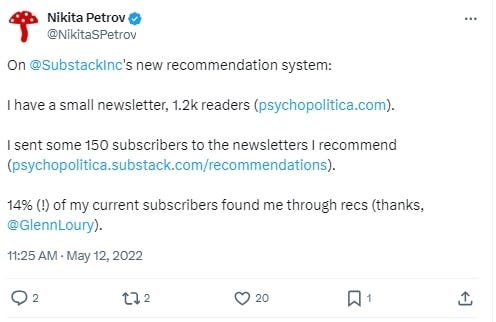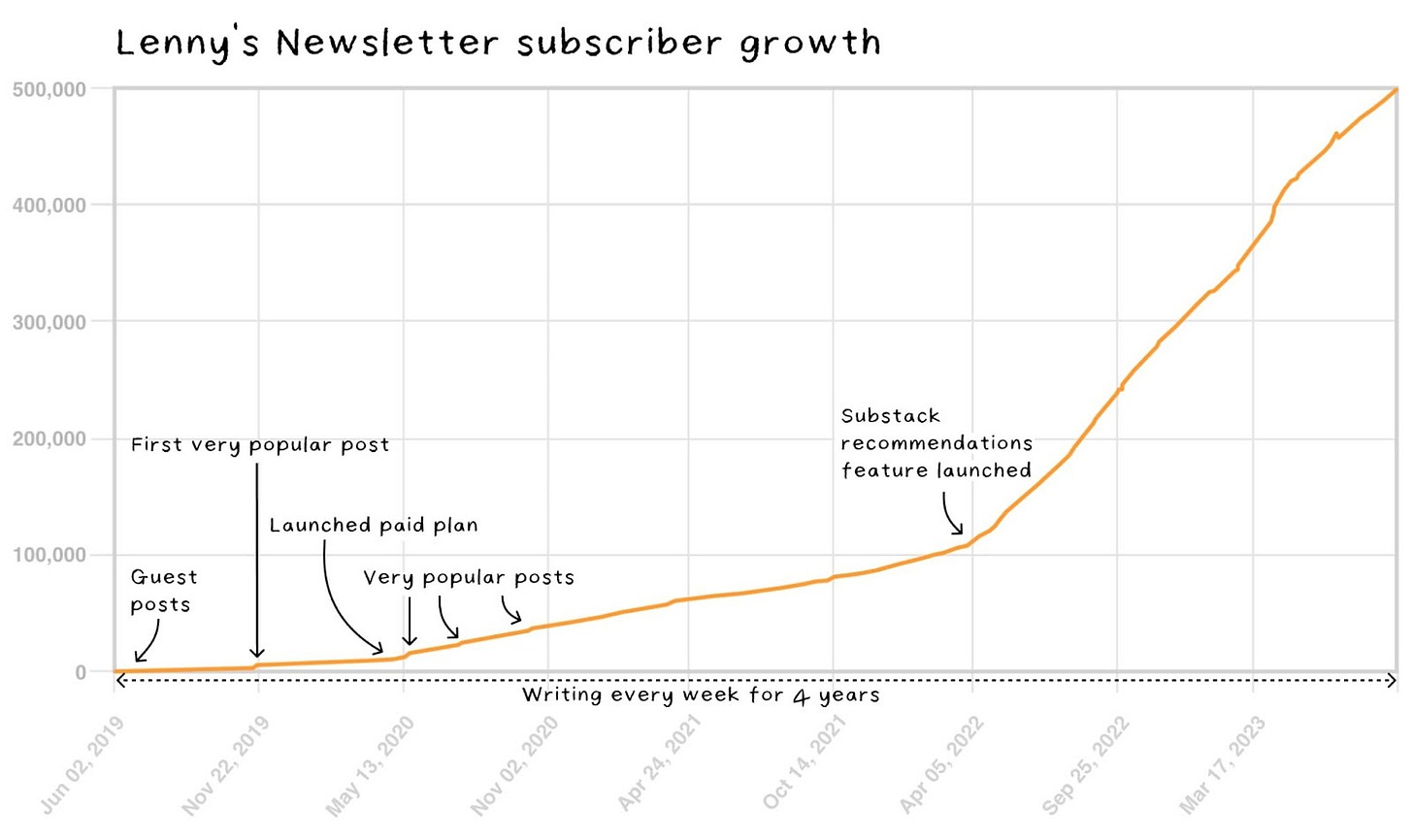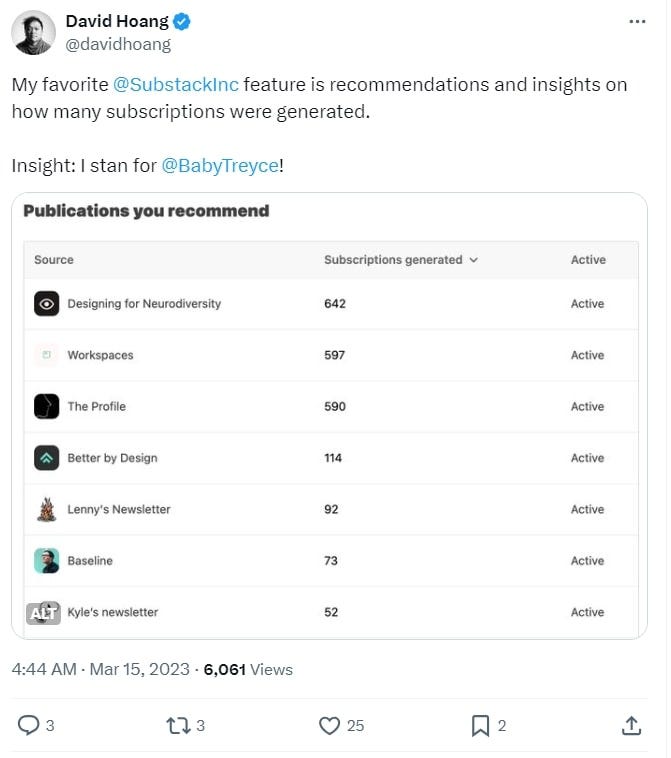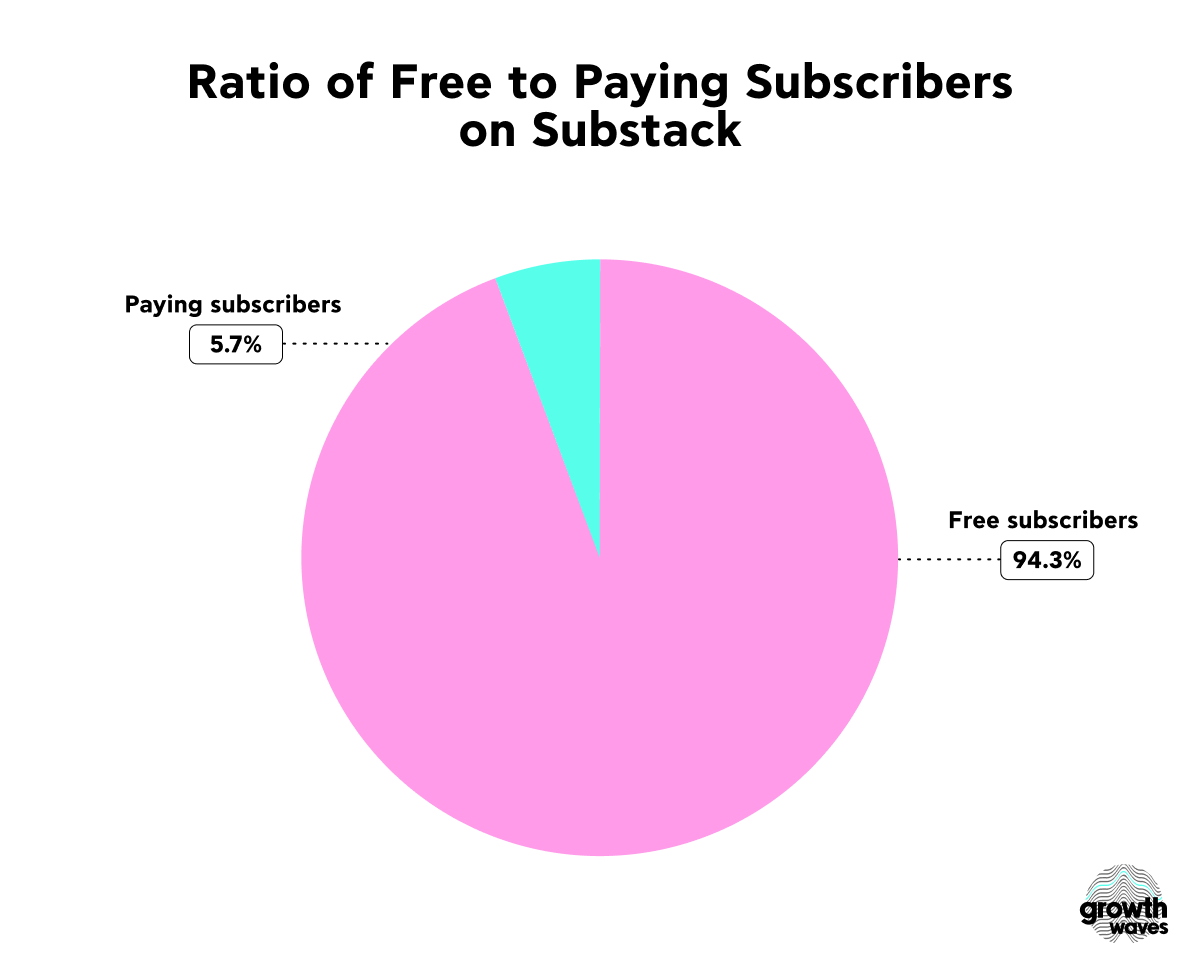3 growth lessons from Substack
The growth playbook behind Substack’s creator-first platform
👋 Hey, I’m George Chasiotis. Welcome to GrowthWaves, your weekly dose of B2B growth insights—featuring powerful case studies, emerging trends, and unconventional strategies you won’t find anywhere else.
17,000 paid writers.
3 million subscribers and counting.
With seven years on the market under its belt, Substack definitely knows a thing or two about growth.
The question is…
Is there something every SaaS business could adopt from the platform’s success?
Let’s explore Substack’s growth journey and see what you can borrow from it.
Key findings
Traditionally, first comes the TL;DR of the Note.
Substack was a response to the market needs. Writers and publishers craved an independent platform where they could remain in control of their work.
The platform operates as a two-sided marketplace. Substack covers both supply and demand while taking a cut (10%) from all paid subscriptions.
Substack invited established authors to provide the supply. The first publisher to join was Bill Bishop, whose paid newsletter generated over $100,000 in revenue on the first day of launch on Substack.
The Recommendations feature closed the demand. The Substack team reported this feature generated over 50% of new subscriptions and 25% of new paid subscriptions in February 2024.
Staying alert to market shifts allows Substack to keep growing as a two-sided marketplace. The most recent features include Creator Studio and Substack Notes, which generated 230,000 new subscriptions between April and May 2024 alone.
Now, let’s explore Substack’s journey in greater detail.
Substack’s growth: A timeline and a backstory
Substack’s growth journey has been quite eventful so far.
In fact, eventful would be an understatement.
Take a look.
And the list goes on.
For this graph, I cherry-picked the most pivotal moments that shaped Substack as the company it is today.
But how did it all start?
Substack was born out of an initiative to help journalists and writers become independent again.
By again, I mean the growing concerns around press freedom back in 2016-2017, especially an increase in cases of self-censorship among journalists.
Chris Best, the CEO and Co-Founder of Substack, shared the following on Joe Rogan’s podcast.
“A lot of the best writers in the world, in my estimation, were getting tissue-rejected from the places where they would have been before. Like an organ transplant that fails.”
There was another reason, too.
The launch of Substack was a response to social platforms overtaking the media landscape and, as Chris put it during an interview with CNBC, “making us angry and dumb.”
But first and foremost, social platforms put a wall between a writer and their audience by forcing their own interests through ads.
And so, the idea behind Substack was to tear that wall down.
Thus, after a discussion with his friend and now co-founder, Hamish McKenzie, Chris decided to give the company a go.
However, it wasn’t your standard Silicon Valley type of launch.
Here’s what Chris shared with Justin Kan during The Quest Pod podcast episode.
“We started not by building some grand system; we started by going to a writer who wanted something like this and asking him what would work for him. So, the first version of Substack was built for him.”
This writer was Bill Bishop, the author of the Sinocism newsletter, one of the first publications that became paid on the platform (more on that later).
Since its inception, every move and update Substack made was to become a space for writers (and other creators later on) to practice their craft and remain in full control.
It’s also seen in the way Substack rolled out new features.
Many of these features were launched as private betas first because Chris, Hamish, and Jairaj Sethi (the third Co-founder) wanted writers to test them first.
Here’s how Chris explained this approach on the Decoder podcast.
“In order to learn, you have to have some opinion or idea to get in contact with reality. You have to have real people interacting with that idea. Then you have to get this information back in a quantitative way through data and in a subjective way through talking to people, and then draw the right conclusion from it.”
The fact that a writer’s creative security is at Substack’s core is also visible from how many initiatives the company launched outside product updates.
Here are the most prominent ones I’ve singled out.
Of course, none of this would have mattered had Substack not allowed the writers to own their work on this platform.
Let me expand on this a bit.
A word on creative freedom on Substack
“The thing that Substack makes possible is for you as a writer to go independent. It didn’t use to be possible for you to strike out on your own and connect directly with your audience, and so you have this incentive to earn and keep the trust of your audience rather than serve whatever other thing you had to serve before.”
This quote from Chris Best from the aforementioned CNBC interview best describes Substack’s drive to support the writers’ creative freedom.
But how does it work in practice?
Substack runs as a revenue-sharing system.
Basically, the platform takes 10% of the revenue if the writer chooses to monetize their content.
It is also possible to run a publication for free.
In fact, according to Backlinko, out of 20 million monthly active subscribers, only 2 million pay for subscriptions, and they account for 5.71% of all subscriptions on the platform.
Moreover, 17,000 writers on Substack get paid.
But who owns their content?
According to Substack’s Terms of Use:
Writers retain full control over their content;
They can export content and their email list if they decide to move on from the platform;
Substack gains exclusive license to use, copy, display, and distribute the content, which is necessary to provide services for writers and their subscribers.
How do these terms compare with other similar platforms?
Let’s see.
As you can see, Substack can only be compared to Patreon in its efforts to ensure full creative freedom.
This further reinforces the platform's core initiative set forth by Chris, Hamish, and Jairaj in this note.
“In the Substack ecosystem, writers can focus on what they do best: producing great writing that earns readers’ respect and support. For our part, we’ll focus on creating a platform that makes everything else—from starting to managing to growing an independent media business—simple and powerful.”
Now, what growth lessons can we single out from Substack’s story?
3 Growth Lessons to Learn from Substack
We can view Substack as a two-sided marketplace.
Essentially, it covers both supply and demand while generating revenue from users on each side of the platform (writers and subscribers).
To achieve this, Substack engaged writers early on to supply readers with content and then launched the Recommendations feature to help creators get more subscribers.
Here’s how it works.
Moreover, to adapt to the changes in supply and demand over time, Substack remains alert to any market shifts that impact the creator economy.
That’s the gist of the three lessons I want to cover.
Now, let’s discuss them individually.
Lesson #1: Providing the supply
When creating Substack, Chris and Hamish were inspired by the success of author and analyst Ben Thompson and his paid newsletter, Stratechery.
By August 2023, this newsletter reached 40,000+ paying subscribers, earning Ben $5M+ a year.
Hamish and Chris knew there were more such Ben Thompsons out there, and that they all had the potential to monetize their creations.
To prove that, they invited a pool of writers who matched the following criteria:
Had newsletters with large subscriber bases;
Had large fan bases and were recently let go from their publications.
Bill Bishop, the author of the Sinocism newsletter about China and a friend of Hamish’s, was the first to join.
The first Sinocism post (according to the newsletter’s archive) appeared on Substack on 19 September 2017.

The subscription to Bill’s newsletter initially cost $11/month or $118/year, but the price has now increased to $60/month or $670/year.

This means that Bill now earns approximately $134M, assuming all his subscribers (201K as of 31 May 2024) have an annual subscription.
Not bad.
But his start on Substack wasn’t unprofitable either.
Here’s what Bill shared with William Turvill from PressGazette.
“On the first day [of launch], I was at over $100,000 in revenue for the year.”
Bill’s subscribers (30K at that time) were more than ready to pay for his newsletter, which was free until he joined Substack.
This effectively proved that Chris’s and Hamish’s assumptions were correct.
The “experiment” with Sinocism was the ultimate driver for other prominent writers to join the platform.
Here’s what Hamish shared in his essay on the two years of Substack.
“After Sinocism’s launch, we were able to attract writers of a diverse group of publications, including The Shatner Chatner, by Daniel Ortberg, co-founder of The Toast, and an anonymously authored newsletter called Petition, about the bankruptcy industry.”
Editor’s Note: Daniel Ortberg has since moved on from Substack.
Attracting high-profile authors ultimately helped Substack get investors, according to Hamish’s essay on five years of Substack.
“[Bill Bishop’s] instant revenue gave us a strong story to tell when, in late 2017, we applied to Y Combinator, the prestigious startup accelerator, setting Substack on a path to explosive growth.”
The next step was to encourage anyone to join Substack, no matter their readership size.
The first initiative (according to Substack’s archive) was the Substack Fellowship for Independent Writers.
Here’s a brief overview of its first installment.
In it, Substack chose five writers who were already active on the platform and supplied them with a stipend and support from three experienced coaches who would help their publications grow.
This program continued alongside others, like a $100,000 grant sponsorship at the start of the COVID-19 pandemic, which Substack initiated to help writers experiencing economic hardship.
However, the most substantial investment in writers was Substack Pro on 12 March 2021.
It was preceded by Substack’s program of giving a small number of writers advances of $10,000-$30,000, which they would eventually repay after becoming profitable.
This system later evolved into Substack Pro, which works the following way.
The pinnacle of Substack’s efforts to engage writers on the platform was letting them become investors.

This effort was so successful that Substack got 6,688 people to invest a whopping $7,809,219 in just three weeks.

Such high trust proved that Substack’s efforts to:
Become a safe haven for independent writers,
Help them become financially secure,
… were successful.
However, I need to highlight one important thing.
Programs like Substack Fellowship for Independent Writers and Substack Pro only engaged a selected group of creators.
What about other authors who publish for free or decide to get paid later?
How could they gain subscribers?
Substack figured out a way to cover both sides of the field (paid and free) with the Recommendations feature.
Lesson #2: Closing the demand
Substack’s Recommendations feature launched on 12 April 2022.
It works as a means of cross-promotion that a writer can use on their own terms for free.
According to the Substack team:
“A writer can select a number of publications to recommend to new subscribers, and the writers of those publications will be notified and prompted to recommend back.”
Here’s how this feature works.
Recommendations were first launched in beta, allowing the writers to share their feedback regarding further additions/improvements.
One such addition was adding recommendations to the publication homepage, i.e., a blogroll.
Here’s what it looks like.

The feature was officially released from beta on 16 May 2022.
You’re probably eager to learn how well it answered the demand.
I’ll say right away that the results did not disappoint.
Within a month after the beta launch, publishers started reporting an increase in subscriber counts through recommendations.
For instance, Nikita Petrov, the author of Psychopolitica, shared that 14% of his subscribers in May 2022 found his publication through recommendations.

In his note on reaching 500,000 subscribers, Lenny Rachitsky illustrated a boost in newsletter growth after the Recommendations feature launched.

I found many similar cases from other free and paid publishers when browsing Substack’s X profile.
Some authors, like David Hoang, shared how many subscriptions their recommended publications have generated, effectively proving the value of this feature.

Substack itself also claimed that writers who made recommendations were three times more likely to be recommended in return.
Notably, the Recommendations feature wasn’t just successful at covering the demand for subscribers but also at driving business for Substack in general.
In February 2024, Hamish McKenzie and Sachin Monga (Head of Product at Substack) reported that Recommendations generated:
50% of all new subscriptions;
25% of new paid subscriptions.
They also asserted that this feature has become an “indispensable part of the Substack network,” which swelled to over 3 million subscribers in the first months of 2024.
Now, both solutions for covering supply and demand were born out of Substack’s profound understanding of the publishers’ needs and expectations.
At the same time, each decision was made based on the changes in the market.
Lesson #3: Staying sensitive to market shifts
As you remember, Substack itself was launched in response to the growing self-censorship among journalists and the limitations of internet freedom.
Substack’s platform became the first outlet, a safe harbor for writers to regain their independence.
As Chris mentioned in the interview with The Quest Pod,
“We were the first ones to get the right ingredients at the right time.”
Having studied Substack’s journey, I can definitely say that every turning point in its growth coincided with major shifts in the market.
One such illustrative moment happened when Elon Musk acquired Twitter on 28 October 2022, followed by a series of controversial events.
Substack responded to this event with Hamish’s essay, in which he aptly notes that every writer on Twitter (now X) is a product, not a customer.
“The machine decides who sees your posts and what gets amplified. The machine decides whether or not your post, or even your account, can stay online. The machine decides what you see. And this problem is true of all social networks. When it comes to Facebook, Instagram, YouTube, and TikTok, the rules are the same. You don’t own your audience. You sublimate your will to those companies. You’re in the cage.”
Soon after (on 5 April 2023), Substack introduced a tool similar to Twitter, Substack Notes, which “fosters deep connections and quality over shallow engagement and dopamine hacks.”
Here’s how it works in a nutshell.
The need for an outlet like Substack Notes soon became evident as Twitter started blocking links to Substack, perhaps viewing it as a threat.
As Hamish put it in his essay,
“It is a reminder of why cracks are starting to show in the internet’s legacy business models.”
On the one hand, reacting to this market shift and launching Notes lets publishers shake off the constraints of the platforms that largely rely on advertising.
On the other hand, it also helped Substack’s business.
According to Hamish’s essay on one year of Notes:
This feature generated 3,000 paid subscriptions and 230,000 free subscriptions between 4 April and 4 May 2024;
One note, an 11-word post, resulted in $8,000 worth of subscriptions.
Substack keeps responding to creator market changes with its newer features, too.
The most recent one, Creator Studio, launched on 7 May 2024 after the U.S. government banned TikTok.
Similar to supporting the writers at the platform's inception, Substack chose five former TikTok creators and provided them with support in transferring their audiences.
We are yet to see the results of this launch, but some TikTok influencers have already brought portions of their viewers to Substack.
For instance, Dr. Harini Bhat from Today I Learned Science is already sharing content on Substack with 6,000 of her subscribers.

Now, Substack claims the launch of this feature is not a direct response to the TikTok ban.
But direct or otherwise, it coincided with a major change connected with a threat to the creators’ independence, much like when the platform first launched.
Conclusion
As Chris Best shared in his interview with TechCrunch,
“The goal is to allow writers and creators to run their personal media empire.”
And, every pivotal moment Substack made to achieve that goal has also shaped it into a media company that now serves thousands of publishers, whose success defines the platform’s success.
In my opinion, pursuing that goal while remaining alert to changes in the creator economy helped Substack grow consistently and stay relevant for almost seven years.
Hope you enjoyed today’s GrowthWaves Note.
See you next time!














